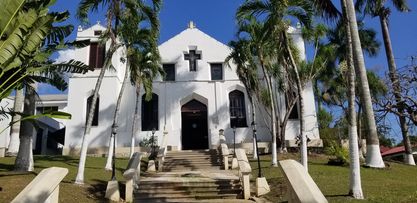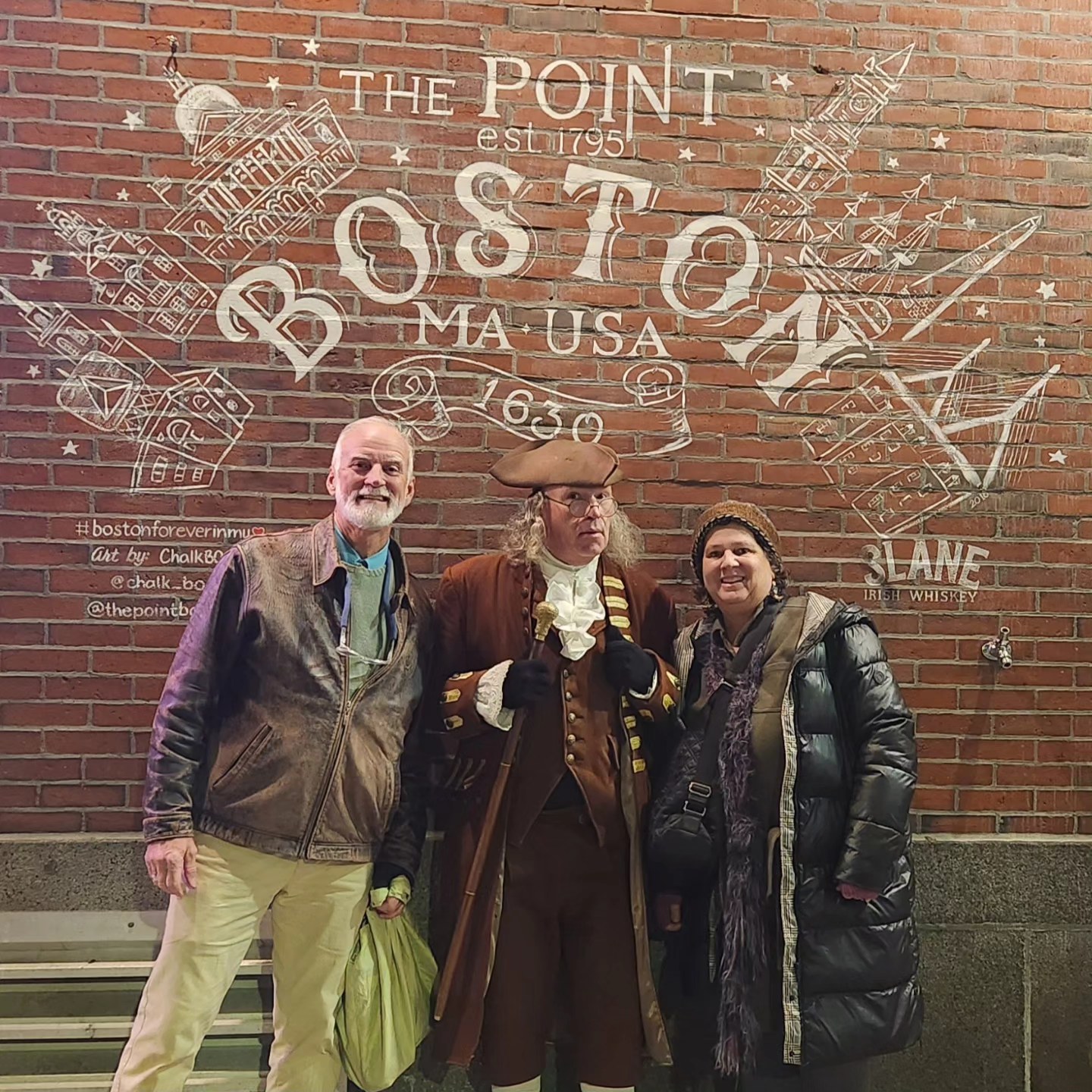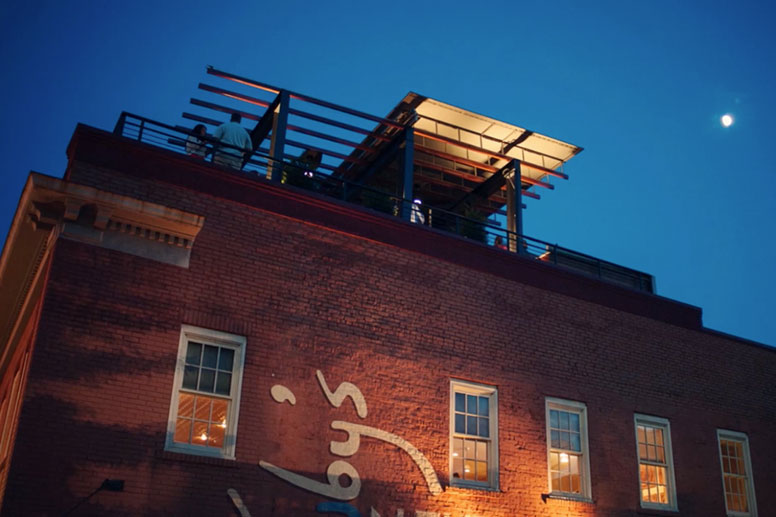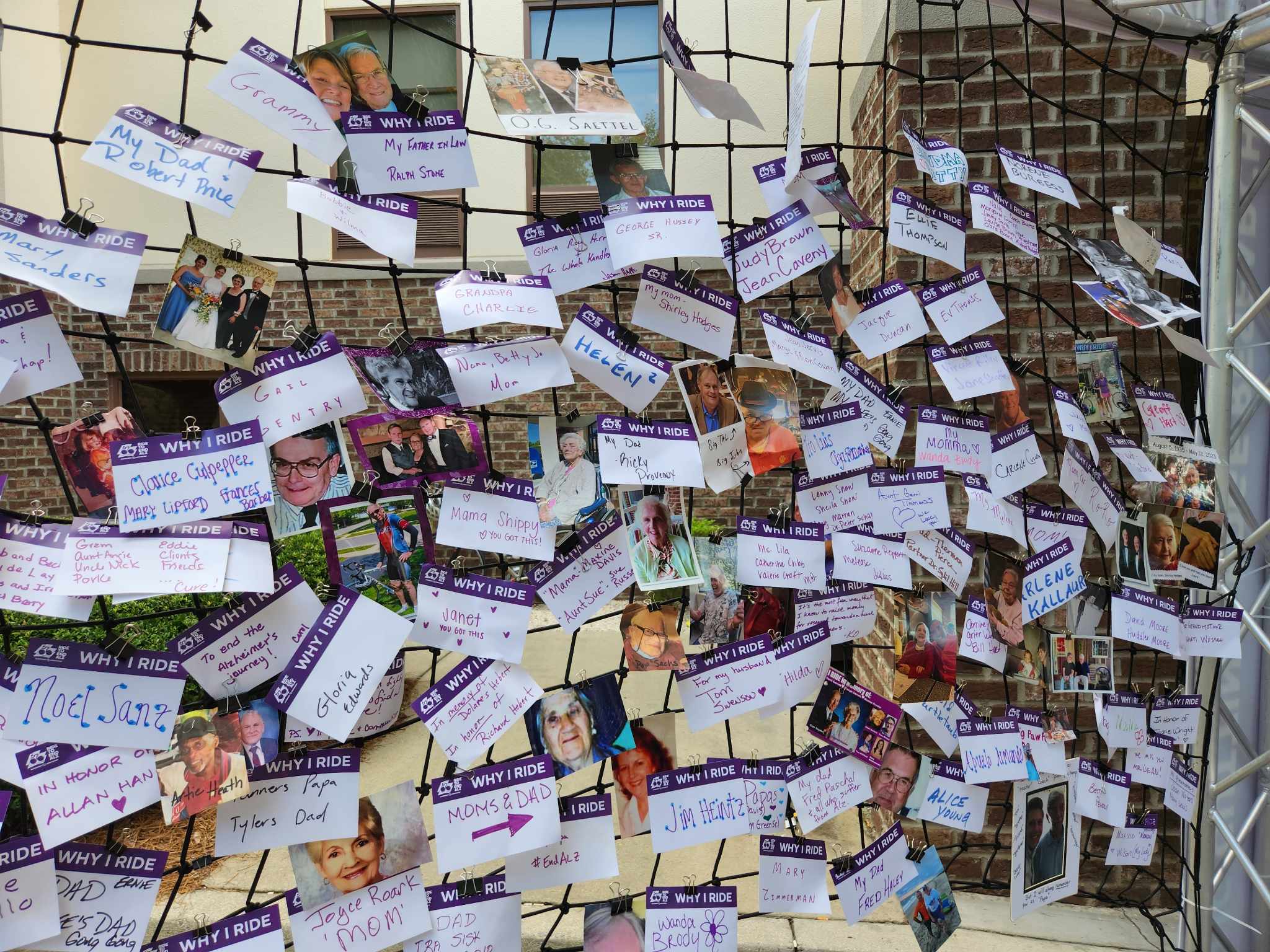Our Lady of Mount Carmel, Banque Viejo
In a 75-year-old church, in a 100-year-old parish, in a town that has every right to despise the Catholic Church, wearing a recently purchased Mayan amulet in the shape of the glyph Mol which depicts the constellation Orion, I sat through a beautiful, emotional Easter service celebrating the resurrection of Jesus Christ.
Banque Viejo is a border town. It’s the western most town of Belize, intersected by the Mopan River, the Macal River, and Guatemala. Its six thousand residents live in compact, colorful homes and it’s crisscrossed with the ugliest, car-hating streets I’ve ever seen. Their paved roads terminate laterally with open gutters a foot deep. No metal grates or cover. A concrete road wide enough for two Minis to pass each other, if their driver side mirrors are folded in, and on both sides of the street lies an open 90-degree concrete trough a foot deep. Good Lord. The statue in the center of town must be a tow truck driver.

Grocery stores named for their Chinese owners, tiny restaurants, bars, and of course auto repair shops are prolific in Banque Viejo. Tourists visit this town for one big reason, the massive Mayan ruins at Xunantunich. It’s pronounced “Zoo nan tuh nich”, its structures date to 1,000 BC. The temples of Xunantunich literally cast a shadow over Our Lady of Mt. Carmel Catholic Church. And in pre-covid times the crowds at Xunantunich would also pale in comparison to the congregation at Mt. Carmel. Serves those Catholics right.
I was born and raised Catholic. At the time of my birth, the Catholic church was the dominant force in south Louisiana. Blame my distaste for Catholicism on college because once I really started to read, when I made that literary journey from cheap novels and autobiographies of combat pilots to actual history, it’s hard to escape the sins of the Catholic church. The crimes of the Popes cast a bloody pall across a wide swath of time and geography, from the Spanish Inquisition to the 1,000-year history of molesting young boys while their benevolent bishops looked the other way; a fate I narrowly avoided while a freshman in high school. My school’s own priest damn near had his way with me and one of my classmates when my high school’s administration allowed him to take us on a “field trip.” My Catholic school’s campus came complete with statues of saints, carved stonecorners finished with quotes from Jesus and his apostles, and some of our teachers were nuns and/or priests. On the surface, this school was a quintessential Catholic high school as it hit all the proper superficial notes. While under its care I was taught our native Americans, including the people of the Caribbean nations, were uncivilized, blood thirsty savages with little understanding or interest in community, education, organization, and communication and most of them gladly accepted the Catholic faith once priests followed in the footsteps of those famous explorers. Those explorers, men from Spain, Portugal, Italy, and Great Britain, were no different than Neil Armstrong, bravely travelling across the unknown dimensions for the good of mankind and civilization. Every bit of it was a damn lie. And while my school was filling me with lies, our own priest, the guy that taught our religion classes, was planning to molest another group of incoming freshmen boys. Is it any surprise the same Church spent a fortune funding men such as Columbus, De Soto, Cortes, Pizarro, or de Leon? Those men and their expeditions were looking for gold and slaves for their Catholic kings and queens, but I’ve been over this already and sometimes it hurts just to write about it.
It’s rare to find me in a Catholic church. Of course, the Episcopal faith I now belong to also has its own bloody history. The Episcopal Church is basically a thick slice of the Church of England between two pieces of American white bread. In the early 1500s, after England’s King Henry the 8th grew tired of his first wife, his royal temper tantrums culminated with a national break from Catholicism and he forced his own countrymen, under threat of the sword, to convert to his new church, the Church of England. When the Catholic and Protestant churches began reaching out across the “new” world, villages such as Banque Viejo were given an option familiar to Europeans. Convert or die. How lovely. The converts were eventually offered the flesh of their new savior, on the holy day of the week, the body and blood of Jesus Christ himself. Convert or die? Once converted, the weekly service you attend is a ceremony to turn bread and wine into flesh and blood. You then eat the flesh and drink the blood of the son of your new God, and that has saved you from the life of a murderous, uncivilized heathen. See the irony?

And to think all of that church sponsored murder, genocide, and slavery happened about 500 years ago, well after humans had learned how to organize, communicate, read, write, explore, learn, farm, preserve food, and fish. Like that Catholic high school of mine, on its surface, European humanity of the 1500s was “civilized” and my history books referred to that period as the golden age of exploration. Doubtful the Mayan’s history affords a “golden” anything to this period in their history. And yet, there we were, sitting outside the beautiful church of Our Lady of Mt. Carmel in Banque Viejo, on the Guatemalan border, waiting for the 10:00 am service to begin while the 8:30 am service was finishing up. And all those historical visions are charging through my head like Sitting Bull at Little Big Horn. Can one, meaning me, still believe in the goodness of the gospels, the beautiful teachings of Jesus Christ, his “love thy neighbor as thyself” messages while also harboring so much disgust for the historical crimes of our modern-day Christian churches?
A Catholic, or Episcopal service revolves around its liturgy. Unlike new age churches, our service has historical form and hierarchy. The altar attendants, the choir, the clergy all process to the altar while appropriate music plays. Depending on the church’s calendar and the time of the day, our service may be short and sweet with little fanfare, or it may be chock full of flowing robes, shining brass, beeswax candles, flowers, banners, and greenery. In those high services our choir may sing traditional, sophisticated songs, some written by classical masters. As Easter is the most important religious holiday for Christians, (rising from the dead is a more important accomplishment than being born courtesy a young virgin) that service is the most sophisticated, most attended, and expectations always run high. There’s a lot at stake in an Easter service because so many folks go to church twice a year, Easter and Christmas. So better make it count if you want any of those folks to show up on an average Sunday. At Our Lady of Mt. Carmel, their Easter service was lovely. It’s likely their budget is 1/100 of our church back home, yet their service was as memorable, as poetic, as emotional as any I’ve attended in the US. Their congregation was as diverse as the fabrics they wore. We were welcomed with smiles, nods, and many “Buenos Dias” and “Felices Pascuas”. The music was sung with passion and although this was an open-air church, and Central America is always warm and humid, no one was complaining about the heat. Padre Antonio’s sermon of brotherly love, the sins of humanity, and the possibility of grace and forgiveness courtesy our risen Christ had me nodding in understanding. And when the eucharist was offered to a church full of sinners, I took it. It’s just a tasteless wafer of flour and a little water, meant as “bread”, produced in some far-away factory of gleaming stainless-steel machinery. And as it sat on my tongue it dissolved into an overwhelming sense of heartache and tears, love and mystery.
The math that defines the Big Bang is so vague, so blurry, so fantastical, so “out there” yet the Christian version of creation reads like an Ikea manual for assembling a DIY space shuttle. What is harder to accept? The idea of a void filled with dust, the dust eventually explodes, and that explosion starting us down a six-billion-year history, courtesy an outrageous mathematical equation that supports and explains the diversity of the rainforest, the simplicity of a chicken egg, gorgeous Ferrari 365s and my wife’s smile. Or, on the opposite side we have the idea of a benevolent creator that always was, always has been, always will be, and he waved his hands, snapped his fingers, then spent six days fashioning the earth and all its life forms, even us, out of mud and bone.

It’s those questions that I often ponder in church. And suppose the answer lies somewhere in the middle, that both sides are half correct? That the beauty and mystery of life, the secrets of our planet, our solar system, our universe, of our purpose amongst our brothers and sisters, the plants and animals we share our home with, is so much larger than we can, or should understand. Suppose the universe is a recipe still under development? Perhaps our capacity to comprehend and appreciate our place in the cosmos was meant to be a mystery, perhaps our six-billion-year-old planet sits just so in our solar system because our creator placed it there. Perhaps Jupiter’s magnetic field providing protection from space-borne debris is not dumb luck but the sign of a loving God. Perhaps there’s a very good reason jaguars have inhabited the earth longer than humans, and birds such as the Red Legged Honey Creeper are way more beautiful than Scarlett Johansson on her best day. Maybe our God, that benevolent creator, personally designed the evolution of the sunflower the same day as my wife’s smile while ignoring the rest of the universe as it bubbled into the darkness like a kettle of soup left on high?

Perhaps we all have a purpose, maybe we are all put here for a handful of reasons and everything else is just gravy. Maybe it is the search for that purpose that gives us our humanity? Perhaps all the good stuff that makes a wonderful woman fall in love with a dumb guy is what we’re searching to understand? The how and why of our purpose. Perhaps the answer to life, the “why are we here” issue, could be a simple answer such as “I’m here to teach 5th graders math, and little kids how to throw a baseball.”
Me? I’m here to cook, I’m here to be a Dad to my kids, a husband to my wife, to teach others to be a better cook and be better leaders in the kitchen. And I’m here to share stories of the people I’ve met and the places I’ve seen.
~ John
You’re reading the year-long adventures of John & Amy Malik in Belize, Central America. We’re professional chefs, restaurant owners, food & travel writers, adventurers, recovering tent campers, and hikers. We prefer authentic street food over a steakhouse, craft beer over traditional lager, a glass of Spanish Garnacha over California Merlot. Should you feel so inclined, please share this essay with someone you’d take on a rustic adventure, and sign up for our next dispatch from Belize. Just click here.







4 Responses
John – I love so much of what you say here, and the comments about Amy are especially endearing.
Thank you Debbie. We miss y’all
and I imagine that you are fulfilling that purpose well! …and that you are being taught humbly by the courageous and creative and purely sincere Belizeans as you allow them to share life w/ you! You are blessed to receive it from them!
thank you very much, Marian.